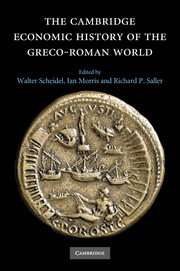Book contents
- Frontmatter
- 1 Introduction
- Part I Determinants of Economic Performance
- Part II Early Mediterranean Economies and the Near East
- 7 The Aegean Bronze Age
- 8 Early Iron Age Greece
- 9 The Iron Age in the Western Mediterranean
- 10 Archaic Greece
- 11 The Persian Near East
- Part III Classical Greece
- Part IV The Hellenistic States
- Part V Early Italy and the Roman Republic
- Part VI The Early Roman Empire
- Part VII Regional Development in the Roman Empire
- Part VIII Epilogue
- Bibliography
- Index
- Map 1.1 The Mediterranean basin"
- Map 10.1 Greek and Phoenician trade in the period of the Persian Wars"
- Map 11.1 The Achaemenid empire"
- Map 12.1 Greece and Asia Minor"
- Map 15.1 The Seleucid empire"
- Map 16.1 Greco-Roman Egypt"
- Map 20.1 The Roman empire at the accession of Vespasian"
- References
11 - The Persian Near East
from Part II - Early Mediterranean Economies and the Near East
Published online by Cambridge University Press: 28 March 2008
- Frontmatter
- 1 Introduction
- Part I Determinants of Economic Performance
- Part II Early Mediterranean Economies and the Near East
- 7 The Aegean Bronze Age
- 8 Early Iron Age Greece
- 9 The Iron Age in the Western Mediterranean
- 10 Archaic Greece
- 11 The Persian Near East
- Part III Classical Greece
- Part IV The Hellenistic States
- Part V Early Italy and the Roman Republic
- Part VI The Early Roman Empire
- Part VII Regional Development in the Roman Empire
- Part VIII Epilogue
- Bibliography
- Index
- Map 1.1 The Mediterranean basin"
- Map 10.1 Greek and Phoenician trade in the period of the Persian Wars"
- Map 11.1 The Achaemenid empire"
- Map 12.1 Greece and Asia Minor"
- Map 15.1 The Seleucid empire"
- Map 16.1 Greco-Roman Egypt"
- Map 20.1 The Roman empire at the accession of Vespasian"
- References
Summary
introduction
The Achaemenid Persian empire at its greatest extent covered an area from the Indus river in the east to Macedonia in the west, from the Aral Sea in the north to Elephantine in Egypt in the south. It was the largest polity that had yet existed in the world. Cyrus II laid the foundation of the empire when he led a successful Persian rebellion against his Median overlord in 553–550, going on to conquer Lydia in 546 and Babylon, which gave him control of the Near East, in 539. Later kings, notably Darius I (522–486) extended Persian hegemony westwards into Europe and eastwards across Central Asia. In a series of battles over 333–331 Alexander defeated the Persians to lay claim to their empire. The Achaemenid Persian empire thus lasted for slightly over two hundred years. It incorporated a myriad of languages and cultures (some seventy peoples and tribes according to Hdt. 3.90–4), as well as diverse forms of economic subsistence. This chapter focuses on one major region of the empire, the Near East.
Given that the Achaemenid Persian empire inherited and adapted pre-existing economic structures in the Near East, some reaching back into the second millennium, if not earlier, and that any consideration of economic growth cannot be confined to just an analysis of the Persian period, it is necessary to draw out the economic history of the Near East in the centuries preceding the rise of the Achaemenid Persian empire, specifically the period of the Neo-Assyrian (c. 950–612) and Neo-Babylonian (612–539) empires.
Keywords
- Type
- Chapter
- Information
- The Cambridge Economic History of the Greco-Roman World , pp. 302 - 330Publisher: Cambridge University PressPrint publication year: 2007
References
- 11
- Cited by



